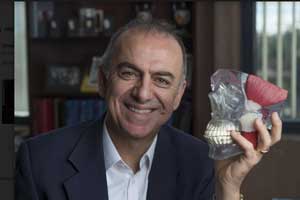- Home
- Editorial
- News
- Practice Guidelines
- Anesthesiology Guidelines
- Cancer Guidelines
- Cardiac Sciences Guidelines
- Critical Care Guidelines
- Dentistry Guidelines
- Dermatology Guidelines
- Diabetes and Endo Guidelines
- Diagnostics Guidelines
- ENT Guidelines
- Featured Practice Guidelines
- Gastroenterology Guidelines
- Geriatrics Guidelines
- Medicine Guidelines
- Nephrology Guidelines
- Neurosciences Guidelines
- Obs and Gynae Guidelines
- Ophthalmology Guidelines
- Orthopaedics Guidelines
- Paediatrics Guidelines
- Psychiatry Guidelines
- Pulmonology Guidelines
- Radiology Guidelines
- Surgery Guidelines
- Urology Guidelines
Breakthrough treatment for crippling jaw defect created

In a major breakthrough, UC led researchers have successfully tested the first-ever tissue implant to safely treat a common jaw defect model, known as temporomandibular joint dysfunction in a large animal model, according to the recent findings published in the journal Science Translational Medicine.
The temporomandibular joint (TMJ), or jaw joint, is a synovial articulation essential for daily functions such as talking and chewing. TMJ dysfunction causes pain and disability in 20 to 25% of adults worldwide.
"We were able to show that we could achieve exceptional healing of the TMJ area after eight weeks of treatment," said biomedical engineering professor Kyriacos Athanasiou and senior author on the study.
Kyriacos Athanasiou and his associates initiated the study to use a tissue engineering strategy to address disc thinning before irreversible degenerative changes of the articulating surfaces occur. The approach attempts to reconstruct damaged discs by repairing and strengthening the existing disc through fibrocartilaginous healing. By preserving joint anatomy, this approach has the potential to reduce degenerative changes at the early stages of injury or pathology, thereby preventing disease progression.
Salient features:
Tissue-engineered implants are durable after implantation
The tissue-engineered implants were evaluated at 2 and 8 weeks after implantation. With the intralaminar fenestration technique, the implants remained in place and did not dislodge. The implants retained their shape and size, were partially fused with the surrounding native tissue at 2 weeks and were completely fused at 8 weeks. There was no evidence of implant breakage or fragmentation. These observations, collectively, indicated that the implants were sufficiently robust to withstand forces in the orthotopic environment.
Allogeneic tissue-engineered implants are safe and tolerated immunologically
CD68 (macrophage) immunoreactivity was rare to nonexistent around or within the implants. Furthermore, there was no histological evidence of multinucleated giant cells, polymorphonuclear cells (neutrophils and eosinophils), or capsule formation around the implants, indicating that the implants were tolerated immunologically and did not provoke a foreign body response.
Tissue-engineered implants prevent gross, degenerative changes to the condylar head caused by disc thinning
Gross and histological examinations of condylar surfaces were informative in determining the effectiveness of tissue-engineered implant treatment in delaying or preventing degeneration of the joint's articulating components (mandibular head and temporal articular fossa).
Tissue-engineered implants adaptively remodel and improve integration stiffness
Eight weeks after implantation, defects treated with tissue-engineered implants showed greater integration (fusion) between the two-disc laminae.
The author said,"This work demonstrates that tissue-engineered implants produced from allogeneic, passaged costal chondrocytes can be applied to treat TMJ disc thinning, a condition is seen in early TMJ disorders that precede severe degenerative changes in this joint. Using an innovative surgical approach, reproducible defects modeling early-stage TMJ disc disease were treated with tissue-engineered implants."
According to the authors, healing was more robust in the implant-treated discs compared with untreated defects, demonstrating repair of a fenestration defect modeling TMJ disc thinning. Repair tissue formed in response to treatment exhibited a greater Young's modulus than that of the repair tissue formed in untreated discs. The implants also improved closure of the pouch and fenestration defects and promoted integration with the intralaminar pouch (greater fusion between the implant and surrounding native tissue).
The authors concluded that a major advantage of the biomimetic TMJ disc implants developed in this study is that they are completely devoid of exogenous scaffold materials. Exogenous scaffolds, such as poly(lactic acid) and poly(lactic-co-glycolic acid), are known to induce a foreign body immune response and capsule formation as well as side effects induced by the by-products of polymer degradation. The intralaminar fenestration technique used in the process of making the implant helps to secure the engineered implant to native tissues without direct sutures. Suturing tissue-engineered implants to tissue defects is a commonly used fixation method.
Athanasiou said that the results might also apply to the treatment of hip, knee and other problem areas. The animals that did not receive the cartilage implants saw a 300 percent increase in osteoarthritis, which many TMJ patients eventually develop, while the treated ones did not.
For more reference log on to
http://stm.sciencemag.org/content/10/446/eaaq1802.full

Disclaimer: This site is primarily intended for healthcare professionals. Any content/information on this website does not replace the advice of medical and/or health professionals and should not be construed as medical/diagnostic advice/endorsement or prescription. Use of this site is subject to our terms of use, privacy policy, advertisement policy. © 2020 Minerva Medical Treatment Pvt Ltd